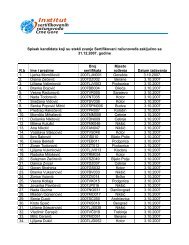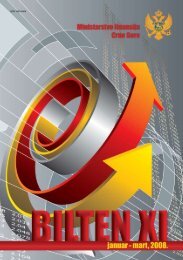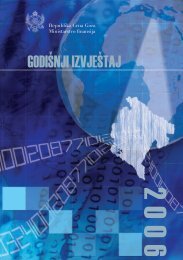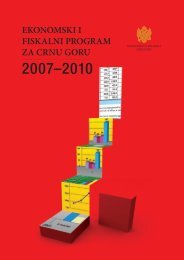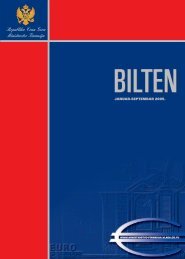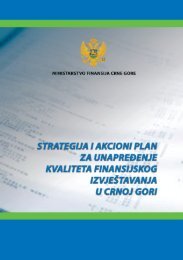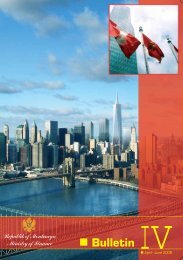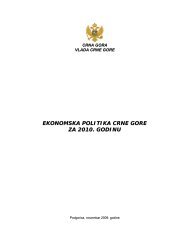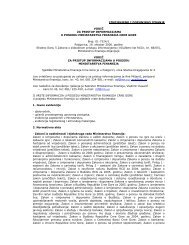Republic of Montenegro: Public Expenditure and ... - Vlada Crne Gore
Republic of Montenegro: Public Expenditure and ... - Vlada Crne Gore
Republic of Montenegro: Public Expenditure and ... - Vlada Crne Gore
Create successful ePaper yourself
Turn your PDF publications into a flip-book with our unique Google optimized e-Paper software.
Chapter 2: Composition <strong>of</strong> <strong>Public</strong> <strong>Expenditure</strong><br />
<strong>and</strong> Key Sources <strong>of</strong> Fiscal Pressure 37<br />
from other countries <strong>and</strong> international organizations should be solicited <strong>and</strong> used only on<br />
the basis <strong>of</strong> the priorities <strong>of</strong> the approved strategy.<br />
• Control the rapid wage increases. The Government may wish to consider, in the light<br />
<strong>of</strong> the evidence from this chapter, whether to approach the teacher unions with a view to<br />
re-negotiating the collective agreement so that wage increases fit within the resources<br />
available. In the future, collective bargaining should include a careful <strong>and</strong> transparent<br />
analysis <strong>of</strong> the impact <strong>of</strong> the salary increases on the education budget.<br />
• Reduce salary costs through staff reductions. In 2006, to keep the wage bill within the<br />
originally projected increase <strong>of</strong> 3 percent (as opposed to the projected increase in the<br />
collective agreement <strong>of</strong> 8-9 percent), the government could reduce wage expenditure in<br />
non-university education through significant reductions in staffing levels. By way <strong>of</strong><br />
illustration, about 1800 staff would need to be made redundant to keep salary spending in<br />
2006 to the projected budget amount.<br />
• Create budgetary space to implement the schools reform program <strong>and</strong> other<br />
priorities to raise education quality. Apart from salary costs, a significant fiscal<br />
pressure is likely to come from the government’s education reform program, which<br />
includes school renovation <strong>and</strong> equipment, <strong>and</strong> a new curriculum <strong>and</strong> associated<br />
textbooks, assessment arrangements <strong>and</strong> teacher training. A cost analysis based on<br />
recently reformed schools shows that the cost <strong>of</strong> school reforms each year in 2006-2010<br />
is projected to rise to two or three times the annual spending to date (€1.8m in 2005).<br />
These costs could be met if reductions are made in the computers bought for schools <strong>and</strong><br />
by slightly slowing the pace <strong>of</strong> new schools included in the reform. However, to make<br />
further savings <strong>and</strong> increase non-salary spending on other priorities, the Government will<br />
need to: (i) reduce the wage <strong>and</strong> salary costs staff reductions; (ii) rationalize the school<br />
network; <strong>and</strong> (iii) reform the vocational training programs.<br />
2.63 While there are potentially significant savings to be made through these measures without<br />
reducing educational quality <strong>and</strong>, in some cases even improving it, the current approach <strong>of</strong><br />
<strong>of</strong>fering voluntary redundancies to teachers <strong>and</strong> other staff is unlikely to be optimal, <strong>and</strong> the<br />
government needs to actively manage staff reductions. In rationalizing the school network, it is<br />
important that the needs <strong>of</strong> students whose schools are to be closed should be carefully assessed<br />
to ensure that reasonable access to schooling remains possible.




